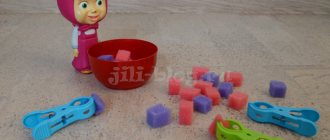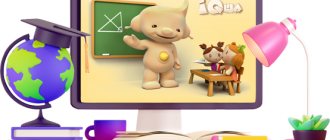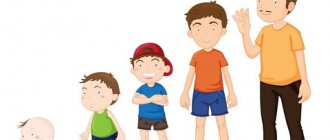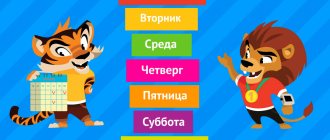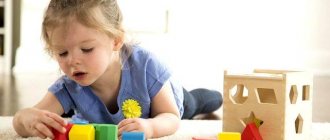Classes for children 4 years old should be developmental and prepare the child for entering school, teach the child to read and write, develop his abilities, and knowledge of the world around him. Experts say that at 4 years old it is already possible to sit a child at the table and study according to manuals for preschoolers. But in practice, a child will not sit for more than 15-20 minutes at a developmental notebook or book - this is the time that each task from such manuals is designed for. There are, of course, children who can sit with developmental notebooks and study with enthusiasm for 30 minutes. But when a child doesn’t want to, there is no need to force him. A 4-year-old child is very active, he is interested in running, jumping, playing with toys, and your task is to develop him through play.
How to teach a child through the game in which he spends most of his time? Let's look at: how to turn games into educational activities for 4-year-old children, what toys and materials will help you with this; What educational notebooks and books do children enjoy studying with?
What and how to develop in classes with children aged 4 years
- Fine motor skills, sensory skills. Model from plasticine, clay; assemble the constructor; make crafts from natural materials and cereals; weave from ropes and elastic bands; plant beads; draw with sand, sculpt from it; paint and draw with pencils and brushes, using different hands and holding the tool in different ways, making different strokes.
- Logic, thinking. Play board games for children (lotto, dominoes, go through mazes); solve riddles; play “What happens if...? (the ball will fall into the water, it will rain, etc.)"
- Attention, memory. Ask questions, for example, about what the child saw on the street when he was walking - “What color was that dog, who did you meet on the playground, what was he wearing, what color, etc.”; ask to talk about a story from a book you just read; collect construction blocks from memory, draw from memory; play reverse cards with pictures that the child must remember, etc.
- Grammar. Learn letters and names of objects starting with that letter in a playful way. When learning letters, you can simultaneously begin to study simple syllables.
- Arithmetic. Learn numbers and counting, addition and subtraction of simple numbers in a playful way.
- Speech development. Learn rhymes. During the game, ask the child to tell, offering him different items and objects: “What kind of object does he see in front of him? What is he doing? What is it for?
- Fantasy and creative skills. Draw; sculpt; assemble the constructor; do crafts; be sure to learn songs and sing with the children; dance to music, learn joint dances; come up with puppet shows, improvise with the plot.
- Physical skills. Dance, with ribbon, sword; play Twister and other outdoor games; do children's yoga; walk on bicycles and scooters, play outdoor games.
- Knowledge of the surrounding world. Study the time on the clock; seasons and months; weather features; animals and where they live; urban and natural sites; forms; textures; smells; colors, etc.
Reading and writing
By the fifth year of life, a child already needs to train his hand for further writing at school. The same goes for reading. Simple rules will help with this. These benefits will help develop the child’s hand muscles and prepare them for further writing. You need to start with the simplest elements - tracing patterns and connecting dots. And only after that you can move on to independent writing.
The perception of the first sound in a word is necessarily worked out. To do this, you can glue letters to any objects in the house. The child’s task is to guess whether the card with the letter is chosen correctly.
REFERENCE! In this matter, Zhukova’s primer will be a good assistant for parents. It describes in detail the sound fusion algorithm and other recommendations for adults.
What should a 4 year old child know?
If your child doesn’t know yet, start learning:
- Times and months of the year.
- Time of day on the clock.
- Days of the week.
- Directions (left, right, up, down, etc.).
- Alphabet and first short words.
- Digits and counting prime numbers.
- Adding and subtracting prime numbers.
- Colors.
- Forms.
- Types of animals.
- Transport.
- Plants and natural objects.
- City objects.
- State of nature and weather.
- Properties of objects and objects and their application (this is how you will develop the child’s vocabulary and speech as a whole).
- City sounds, sounds of nature, animals, etc.
- Smells.
Required additional activities for children aged 4 years
- Singing.
- Studying the rhyme.
- Solving riddles.
- Reading with mom.
- Dancing.
- Physical exercises (on a fitball, with a tape, a bicycle, a scooter, a ball and other games that develop the child’s physics).
- Applied arts (drawing with brushes and pencils using different hands and holding the instrument in different ways, modeling, applique, weaving)
We have already written articles on how to teach a preschooler some of the above skills - read in more detail by following the links with the skills you need.
Development of attention
In order for a preschooler to be able to easily switch from one type of activity to another, concentrate his attention on work for a long time and not get tired, attention also needs to be regularly developed.
Game options:
- Find changes in the appearance of the adult and in the arrangement of objects.
- All kinds of variations of the game “edible-inedible” (shoes are not shoes, speaks - does not speak).
- Find the differences in two pictures.
- Game "Trailers". The mother names the object, the child repeats and adds his own, the mother now repeats two objects and adds a third. And so on until someone makes a mistake.
- While walking near the house, you need to remember as many details as possible, and the next day discuss what has changed in the environment.
- With your eyes closed, describe what and exactly where it is in the room.
Activities for children aged 4 years using benefits
It is better to buy all manuals, books and notebooks in bookstores, rather than download them from the Internet and print them on a home printer. You won’t find material of decent quality on the Internet, and when printed on a home printer, it will deteriorate even more - you can’t offer this to children, you risk ruining all the fun of the lesson. But even in a bookstore, you need to choose with special care, so that the book is compiled by progressive specialists, the tasks are clear and interesting to the child, and the pictures awaken additional interest in the lessons.
- The manual “Annual course of developmental activities (for gifted children 4-5 years old)” includes a full annual course of developmental activities for children 4-5 years old in the main areas of preschool education: literacy, mathematics, preparing the hand for writing, getting to know the outside world, development of speech, logic, attention, imagination.
- Set of 7 manuals “School of Little Geniuses. For 4-5 years old" is a comprehensive program of classes that covers all areas of child development and education and complies with the Federal State Standard for Preschool Education. Each kit contains methodological material to prepare a child for school and general development. Each book contains entertaining educational tasks, exercises and games.
- Manual “Annual course of studies. For children 4-5 years old" contains the main topics of preschool education, with pictures of the child's favorite multiplex characters.
Recommendations for choosing a benefit
What to look for when choosing developmental aids, books, workbooks with tasks for children 4 years old:
- Almost all manuals with tasks are designed for a certain age and it is indicated on the cover - select by age.
- Activities for children for 4 years old must correspond not only to their age, but also to their abilities - the child must solve all the tasks assigned to him without making excessive efforts, otherwise he will need to move on to easier tasks, and there is nothing wrong with that. This way you will maintain your child’s interest in classes without discouraging the desire to learn.
- Choose professional authors who compile manuals; usually their experience and qualifications are described in the manual itself - the author must have a specialty and considerable experience in teaching preschoolers.
- Choose manuals with high-quality illustrations - this is very important for children. Illustrations should be: colored in calm colors, consistent with the original objects, without excessive brightness; aesthetic, kind and sweet; understandable for a 4-year-old child, with the basic features of identifying objects (the hare should look like a hare); depict adequate emotions, gestures and movements; images must correspond to the text and be consistent; There should be air around the images (white background) for better perception.
All these recommendations are met by manuals from KUMON (the world's largest children's additional education center), which contain high-quality illustrations and assignments compiled by highly qualified specialists.
- Manual “Logic and Thinking”
- The manual “Getting ready for school. Learning numbers and shapes. For children 4-5 years old"
- The manual “Magic labyrinths. For children 4-6 years old"
- “Learning to tell time. An hour and half an hour. For children 3-5 years old"
- And other benefits from the KUMON training center"
How to study with benefits
Classes on manuals, at the initial stage, should take 15–20 minutes. A four-year-old child is not able to sit for more than this time, and you should not force him. Choose those tasks from the manual that the child is more likely to be interested in, unless a clear sequence of tasks is recommended. Don’t forget that it is important to do everything with pleasure, praise your child for completing a task correctly, and not scold him if something doesn’t work out. Remember that these rules are important, especially if you want your child to study well and with interest in the future.
The manuals contain activities for children aged 4 years:
- on the development of logic and thinking;
- attention and memory training;
- imagination and creative skills;
- training fine motor skills of the hands;
- literacy tasks;
- arithmetic tasks;
- tasks for speech development;
- introducing the child to ideas about the world around him.
There are manuals for each of the areas separately, and there are those that contain all the necessary categories, which is quite convenient.
Educational activities for children 4 years old in a playful way
The child is constantly in the game; parents only need to include the educational aspect in the game. Almost all games can be turned into educational activities for children 4 years old and older. And almost all toys can become educational material.
Constructors
Construction sets come first among educational toys. The construction set is a toy without gender division, as was previously thought; it will be equally interesting to both boys and girls. It is advisable to choose sets not only with different blocks, but also with characters, auxiliary items and objects. There are construction kits with the alphabet printed for learning letters; there are numbers and addition and subtraction signs; also constructors that introduce children to the world around them, animals of different countries and continents, seasons, professions. For example, “Lego Duplo” - in this series the parts are quite large, there are sets for the little ones from 1 year old, and there are from 2-5 years old. The following series of the designer come from 3 years of Lego Classic - it has smaller parts and there are more of them in the sets. You can choose separate series for boys and girls.
Games with a constructor, we develop:
Fantasy and speech skills
Ask your child questions while playing, let him imagine what will happen next. Let's give the task to come up with a new figure from the designer, it is not necessary to assemble only according to the diagrams. Act out scenes with the characters of the designer, come up with names for them, activities, where they will live, who they will be friends with.
Logic
Just build from blocks, with or without diagrams, create your own schemes. Draw a shape, the boundaries of an object or a letter on a piece of paper with a marker, and let the child put it together from blocks. Set boundaries for colors and shapes. The cubes can be used in many ways, even making patterns on the floor. You can write numbers and letters on the cubes and stick small stickers on them; then give the child tasks: to put together such cubes with images according to some characteristics or meaning. Build a labyrinth out of cubes, ask the child to go through it on his own, ask him to build a labyrinth for you.
fine motor skills
The smaller the parts, the more quickly the child learns to handle them, developing his fine motor skills.
Attention and memory
By assembling the construction set according to the diagram attached to it, the child learns to follow it carefully. There are a lot of separate books with new patterns for the Lego constructor, which can be purchased additionally in bookstores. You can draw up your own diagrams, sketch them, make your own catalogue—isn’t that an interesting project? You can also use these skills during the game itself, for example, by giving the task to collect from memory, as before, all the cars of a collided and crumbled train, etc.
Grammar
You can use a marker to write the letters of the Russian alphabet on the cubes, or stick stickers with letters and other images on the cubes, which you can also do with your child. These little stickers are sold in bookstores for planners. With the help of such prepared blocks, you can teach a child: asking you to select a letter to the desired image, putting the letters into syllables by connecting the blocks. You can make printed letters from the blocks themselves, after first drawing a diagram on a piece of paper. You can use blocks with letters and other images along with educational notebooks and books to make your learning more interactive and interesting.
Counting, addition and subtraction
Use number blocks and addition and subtraction signs that you can prepare with your children as described above. Or, for example, play a construction game: ask for a certain number of blocks of a certain color to be delivered to you, then add a few more of a different color, and stuff like that. The child perfects his counting in such interesting games.
Speech development
Use cubes with stickers depicting various objects - this way you can play store with characters, asking the child, in the role of a consultant, what he will recommend and why. Help him by introducing new words and let him use them in his explanations. Provoke your child to comment on the actions in the game - ask guiding questions. Learn to structure sentences correctly: by playing, for example, on a tourist excursion or in a train station, announcing the necessary announcements for train passengers.
Pros and cons of the designer
Pros of the construction set: If you use your imagination, the construction set is a very multifunctional toy, with it you can come up with a lot of educational activities for children of 4 years and almost any preschool age, and besides, it is so interesting.
Disadvantages of the designer: Many parents complain about small parts scattered throughout the house. However, this can be dealt with: build a special play mat for the construction set; which is pulled into a bag, collecting all the parts, at the end of the game.
Parents also note that their child assembles construction sets only according to diagrams without showing imagination. There is a solution here too - buy classic Lego Classic blocks, they are designed so that the child will come up with figures and games on his own.
Board games
Board games are very popular today. This is not only educational activities for children aged 4 years, but also a fun time with parents and friends, the joy of winning, and training in an adequate attitude in case of loss. Board games are designed for different ages of children; for preschoolers these can be: puzzles for learning the alphabet; dominoes with images, numbers and letters; various walkthroughs with simple rules; or card games with beautiful illustrations. All this can be found in toy stores.
- Good educational games for preschool children are published by the publishing house LISCIANI; you can choose individual games for the development of any skill or sets.
- Another good manufacturer of educational games is Miniland. The games are intended for the development and education of preschool children.
- And of course, the quite popular “Tenth Kingdom” produces a very large assortment of educational and educational games for children, with their favorite cartoon characters, for children of different ages.
- When looking for a game to develop a specific skill (learning letters, writing, reading, counting), consider all publishers of educational children's games. The choice is large, but you can find almost everything you need for educational activities with children.
The advantages of children's board games: Such games are built according to a ready-made plot (rules invented by the developers), you do not need to come up with tasks yourself, as with a construction set.
Disadvantages of board games: They have limited functionality and are almost always limited by instructions.
Favorite toys
Any children's toys can become educational activities for children aged 4 years, here it is the same as with a construction set - the main thing is to show your imagination.
Some ideas for playful activities for boys
If your child loves cars, you can stick letters or numbers on them and make a parking lot for them. For each parking space, stick or draw an image whose name begins with the letter pasted on the car. Or paste the number of images that are written in numbers on the typewriter. Stick addition, subtraction, and even signs on the cars - and you can solve examples while driving around the playing field (track).
On whatman paper you can draw a route with cities, forests, natural and architectural places, you can even depict weather conditions. When driving along such a highway, study the directions with your child (left, right, up, down); develop your speech by asking questions - “What happens if you turn left, where will you arrive? What can you do there?"; draw route maps so that the child follows them to reach the desired destination, this way he will train attentiveness.
Show your imagination and come up with your own games and tasks, in them you can develop and learn everything that teachers teach children 4 years old in preschool institutions.
Several ideas for playful activities for girls
Almost all girls love either dolls or toy animals - and there is a huge scope for imagination. You can also learn the alphabet with dolls and animals by sticking letters on them; Give candy to the dolls, let the dolls share with each other, count how many candies the dolls have under different conditions, etc.
Dolls and animals are great tools for role-playing games. We play shop (we study addition and subtraction, letters, how to write the names of products, develop speech and thinking). We play theater (we develop imagination, speech, logic, memory, thinking) - we come up with short scenes, characters, names, memorize short poems; you can take a fairy tale from a children's book and stage a puppet show with toys based on the book.
Even a simple role-playing game of improvisation will help develop all the necessary skills - ask the child as many questions as possible about the environment, talk about what he does not yet know.
Advantages of educational activities with favorite toys: The child is already immersed in games with his favorite toys, offer new scenarios in his game - interest in the activities is guaranteed.
Cons: You will have to actively use your imagination when developing a scenario for developmental activities, prepare additional materials (printouts of letters, numbers, cards with additional items). Although all these additional materials can be bought at a children's or bookstore.
Available materials
Perhaps the most creative educational activities for children aged 4 years are crafts from scrap materials. A variety of projects can be created from: natural materials, cereals, empty packaging, household items, paper and special materials for creativity.
Start with what you want to do (what task is ahead of you: learn letters, develop fine motor skills, etc.), what specific available tools are suitable for this, how to reliably glue or connect them - you need to show so much ingenuity. If you want to grow a creative personality, then more often resort to games made from improvised and natural materials.
Cereals and other small bulk objects (we develop motor skills and sensory skills)
Cereals can be sewn into toys made of thin fabric.
You can place the flour in an inflatable ball, deflate the air and tie it in a knot - the ball will hold its shape well. You can additionally decorate it with plastic eyes and attach hair (a thread tassel).
You can draw with grains and sand by placing them on a tray or gluing them to a sheet of paper.
By pouring cereal or sand into a box, you can make a playing field (beach, construction site, garden) for a child to play.
Paper
Children's origami, the simplest, can be done by a child as young as 4 years old.
Applique: You can help your child by drawing simple shapes, let him cut them out with children's scissors and glue them himself.
You can cut out any objects for learning from paper, make educational notebooks with elements of appliqué and drawing (a doll's house, a track for cars with different locations, a forest, a city, a store, etc.) Use ready-made stickers in such notebooks, children love them very much .
Tubes, toothpicks
Cut tubes or use matches to fold an applique or build a house, use glue.
You can make a chain from the short parts of the tubes, connecting one end to the other.
You can make a hedgehog or a porcupine from a toothpick and potatoes.
You can build a helicopter from tubes, thick paper and a toilet paper roll, then paint it with acrylic paints.
Natural materials (cones, twigs, pebbles, acorns...)
From all this goodness you can get a lot of crafts of animals, birds, and people. Use plastic eyes, bright threads and colored paper.
Large smooth stones can be painted and turned into fancy creatures by attaching eyes and rope tails to them.
Threads and balls
Remember, you probably made dolls and animals from pompoms out of strings.
Threads can be woven and tied to mesh fabric to create intricate patterns.
And these are just a few of the ideas that can be developed using available materials. Lesson principle: lay out the necessary materials in front of the child, give a direction, offer to make a craft using a little ingenuity. Guide your child, offer your ideas if he is at a dead end. A child, coming up with and bringing such ideas to life, develops not only creative skills, he learns logic and non-standard thinking. And be sure to accompany your classes with guiding questions, counting, writing letters or numbers, come up with names, stories, study everything that comes to your hand.
Daily routine
And don’t forget that your educational play can be used to benefit the household and develop independence in the child. What kind of household chores can a child be entrusted with?
Cleaning. Think in advance about each place (house) for toys, where they will live when they are not playing with them. By the end of the game you will need to send the toy to rest (go home to sleep). And be sure to follow with leading questions - “What will your black fluffy bear cub do at home before going to bed? Place a (toy) piece of fruit next to him for him to eat before bed. What fruit will you put in? What colour is he? Maybe put another one, how much fruit will the bear have then?” etc. Each item can be assigned a place (house) to which it must return to rest, otherwise it will become wrinkled, dirty (dusty), or lost.
Loading the washing machine and dishwasher. This is also a kind of quest for a child - to sort all things by color, texture, shape and purpose, set a program, there are numbers and letters that need to be remembered until next time. Children really like to press buttons, let them do it under supervision, - “I’ll check for you so that you don’t forget anything, otherwise you can break it...” - and then explain that - “When the program is running, you can no longer break it by pressing buttons, like and you can’t press it just like that, because it might break and flood your neighbors and us...” Be sure to accompany all actions with detailed explanations. Trust to load the dishes in a certain order, put one piece of dishes next to another of the same kind, set the program, etc.
Cooking. It’s a creative process, but you need to stick to the recipe, study new ingredients, their smells and tastes, and keep count. Trust your child to add to a recipe, explore and learn about ingredients, mix, layer, decorate, keep track of time—anything he can help with in cooking that will broaden his horizons and be appropriate for his age.
Interesting drawing lessons
Children of senior preschool age love to draw. They already have skills in handling brushes and paints, felt-tip pens, and pencils. Drawing develops speech, fine motor skills, imagination, perseverance, and attentiveness.
To teach your child to depict various objects, you can use the following methods:
- tracing figures with a dotted outline. The child will remember the shapes of different objects;
- use of coloring books;
- carbon copy drawing (outlining already prepared images and then coloring them).
When teaching a child to draw, you need to use simple lines and geometric shapes. There are many interesting lessons.
Master class on depicting a deciduous tree:
- draw a tubercle at the bottom of the sheet;
- above it (at the top of the paper) draw a circle;
- connect two objects with straight lines (this is a trunk);
- draw branches;
- give the edge of the crown unevenness (highlight those places where the branches enter);
- Draw grass on the hillock.
